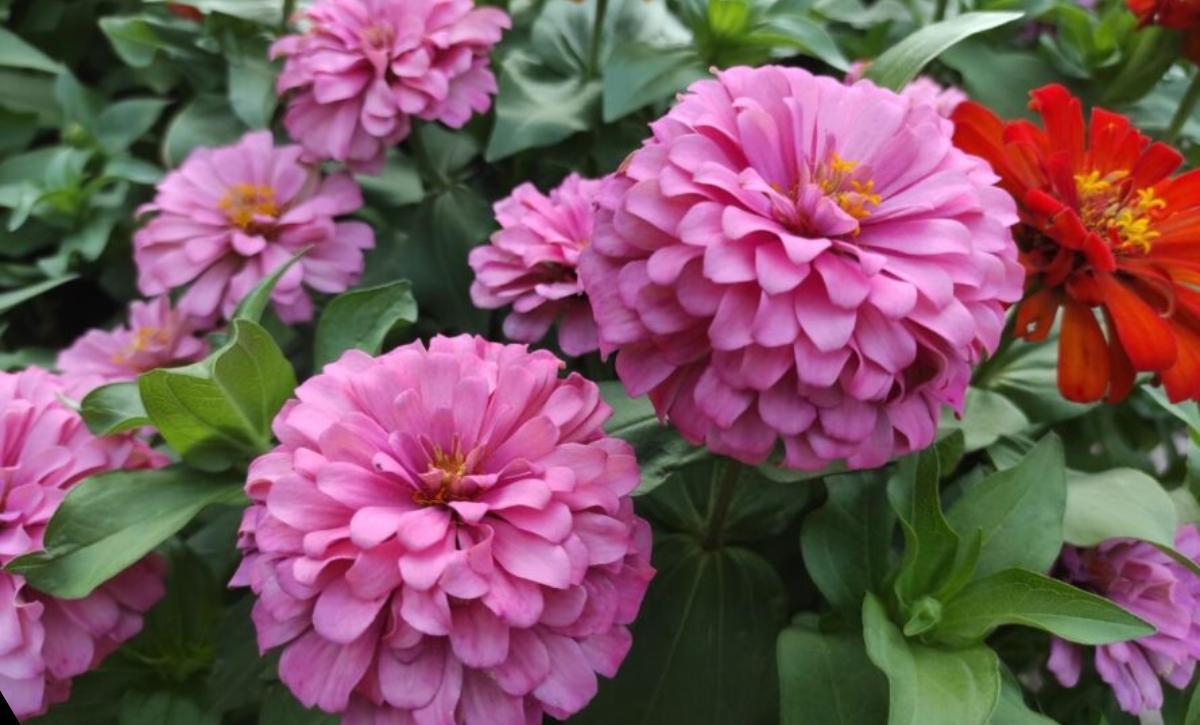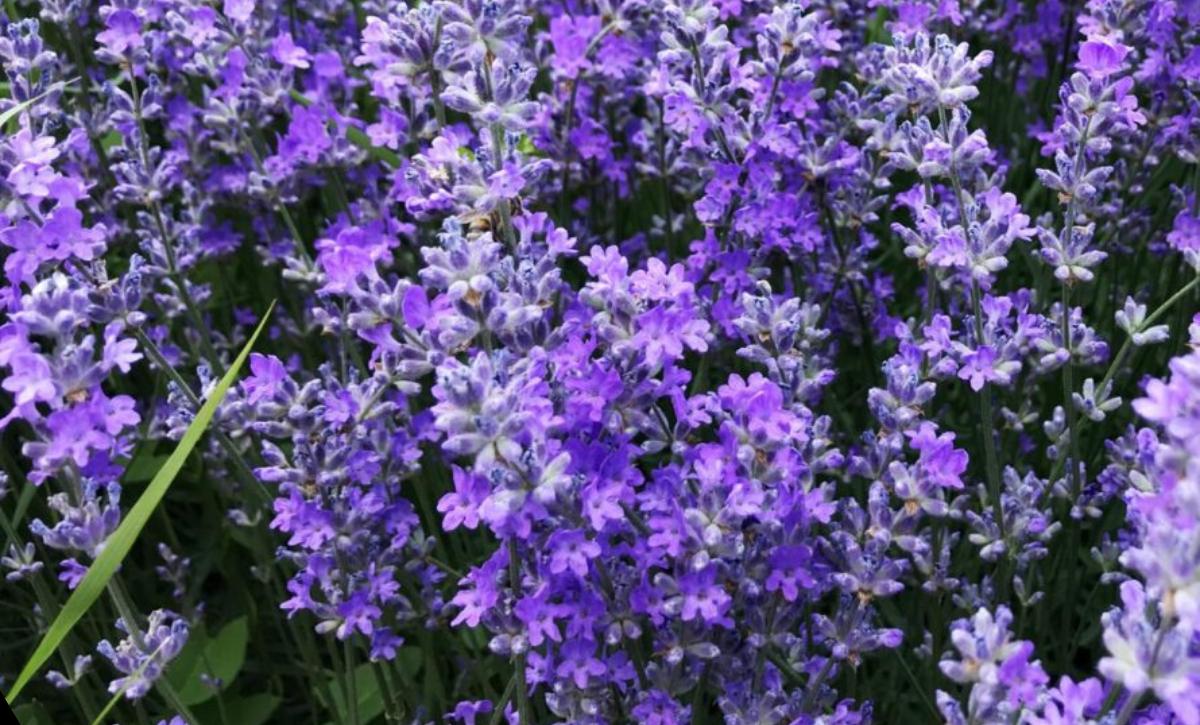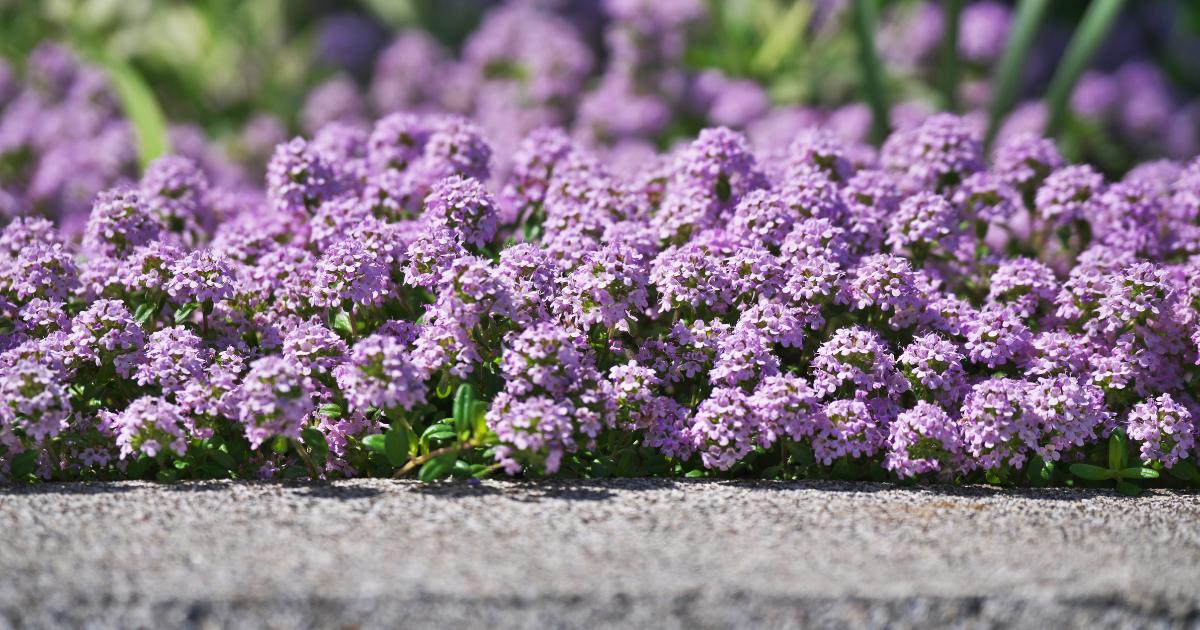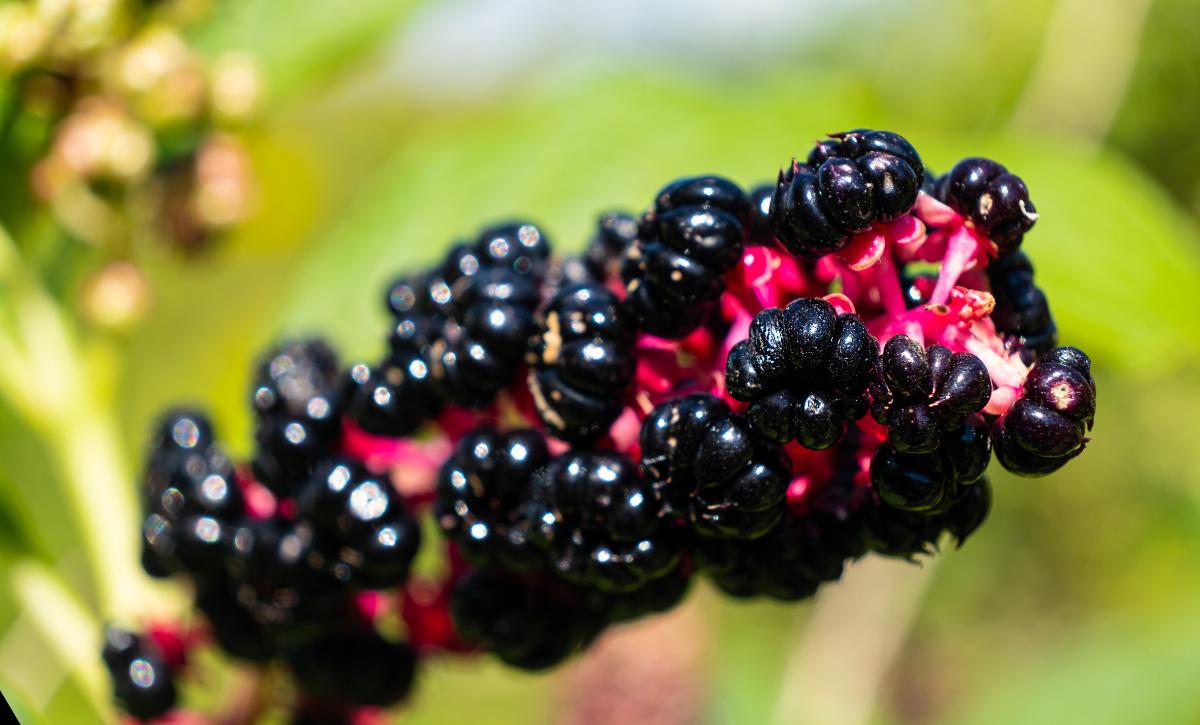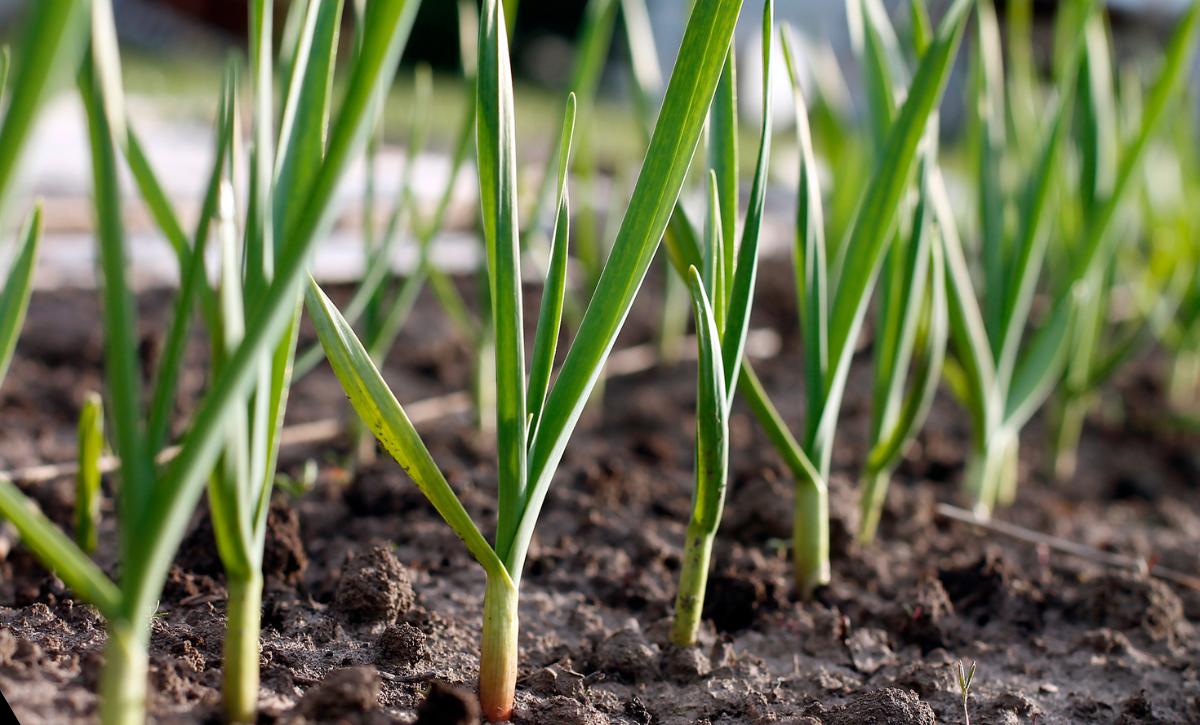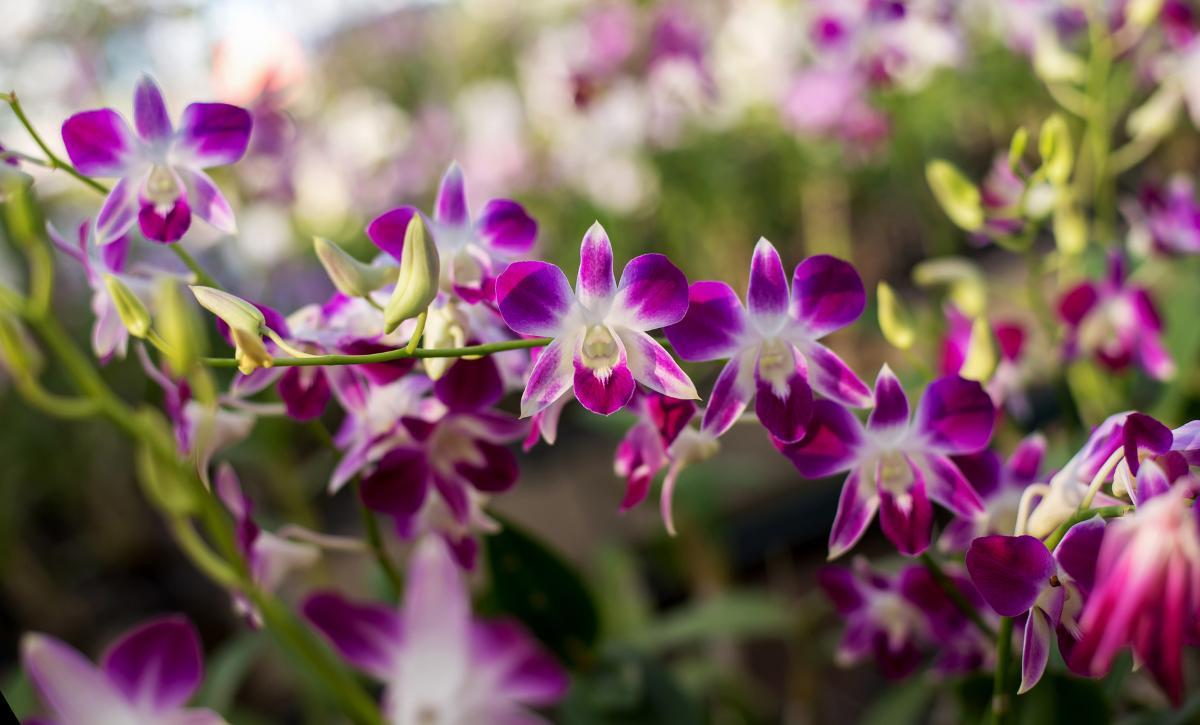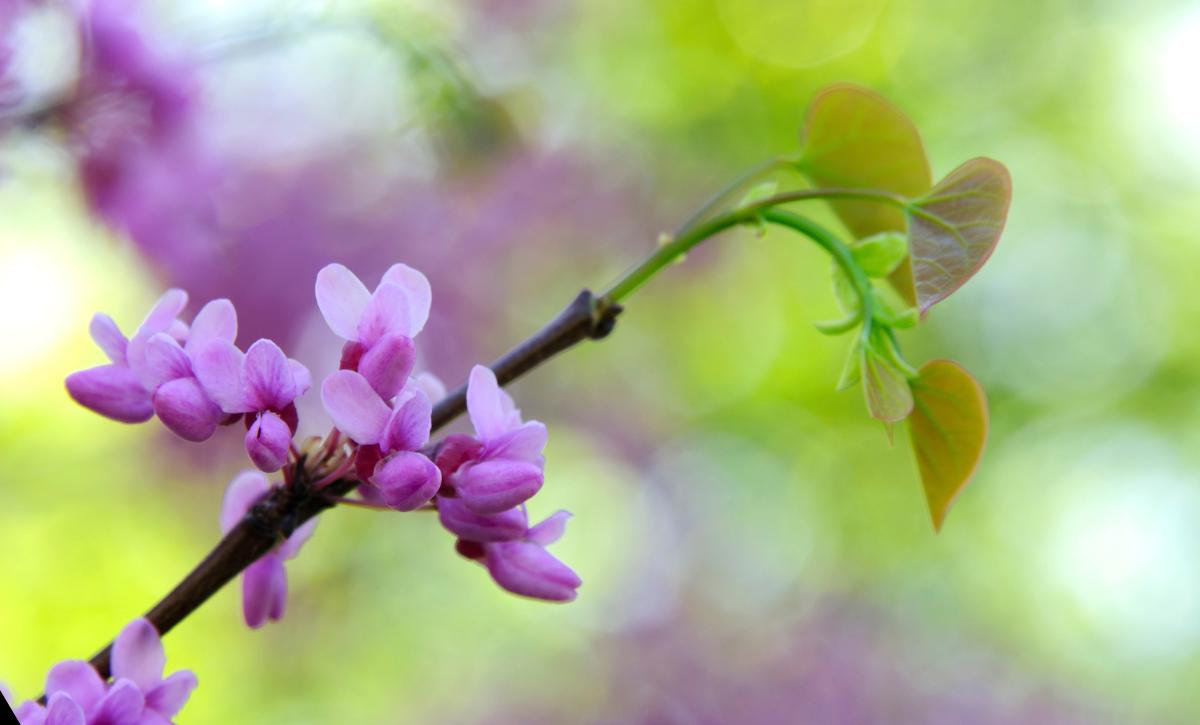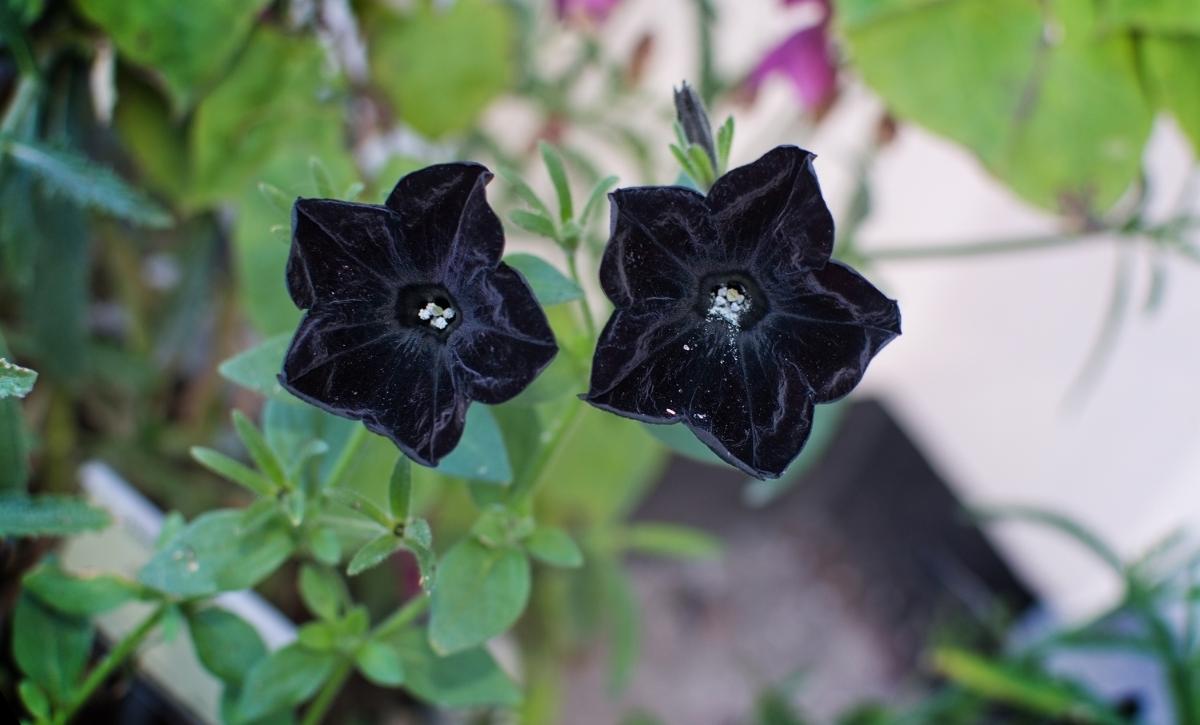France has always been known as the romantic nation of the world, and this is embodied more in its elegant flowers. If you yearn for that Gourdon kind of look, French flowers such as peonies, red poppies, and lavender are the answer. They will have your garden screaming, “Bonjour, la France!”
In this article, we’ll look at 16 different species of flowers native to France. The article will provide the meaning of these flowers, their basic characteristics, as well as their French flower names.
We hope this article will help you achieve the dream garden you’ve always wished for.
16 French Flowers
France is known for its numerous varieties of flowers, but we’ll only discuss the 16 most popular types.
In this section, we’ll present you with some of the most beautiful flowers that you can adorn your home or garden.
Let’s take a look!
1. Chrysanthemum
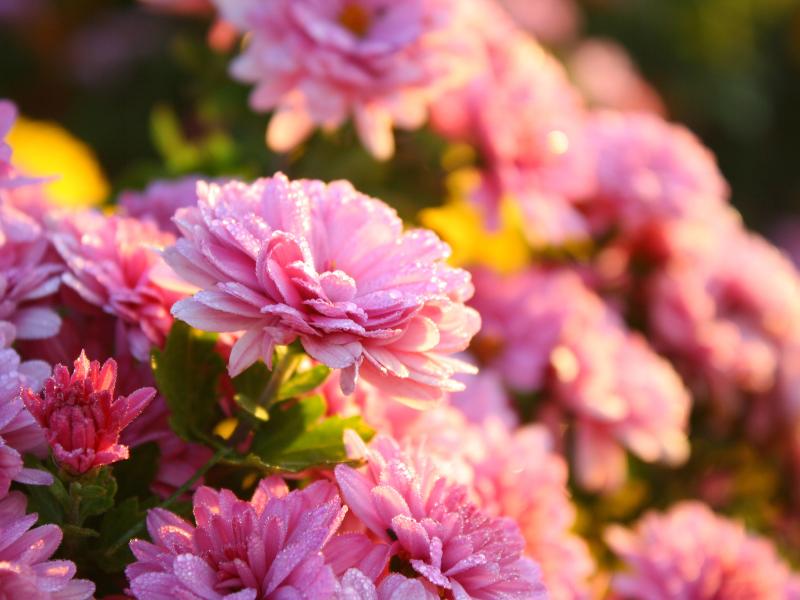
| Scientific name: | Chrysanthemum |
| French name: | Chrysanthème |
| Native habitat: | East Asia and Northeastern Europe |
| Growth rate: | Fast grower |
| Size: | 30-90 centimeters (1-3 ft) tall |
| Toxicity: | Toxic to cats and dogs |
These colorful flowers come in shades of red, orange, yellow, purple, lavender, and white but can also be bicolored. An early chrysanthemum bloomer will start showing its flowers in late June, while early fall bloomers will show off their attire in September. Late chrysanthemum bloomers show their flowers in October.
These flowers are relatively easy to grow, and they’re also known as mums. The flowers need a sunny, well-draining spot and frequent watering throughout spring, summer, and fall. Cut back on watering during winter when the soil freezes. All you need to do is water them to a depth of 15-20 centimeters (6-8 inches).
In France, these flowers symbolize death! In the USA, however, they represent friendship, well-being, and happiness. You will often see them at funerals since they symbolize immortality. Wait for All Saint’s Day to come; you’ll see flower shops brimming with them everywhere.
2. French Daffodil
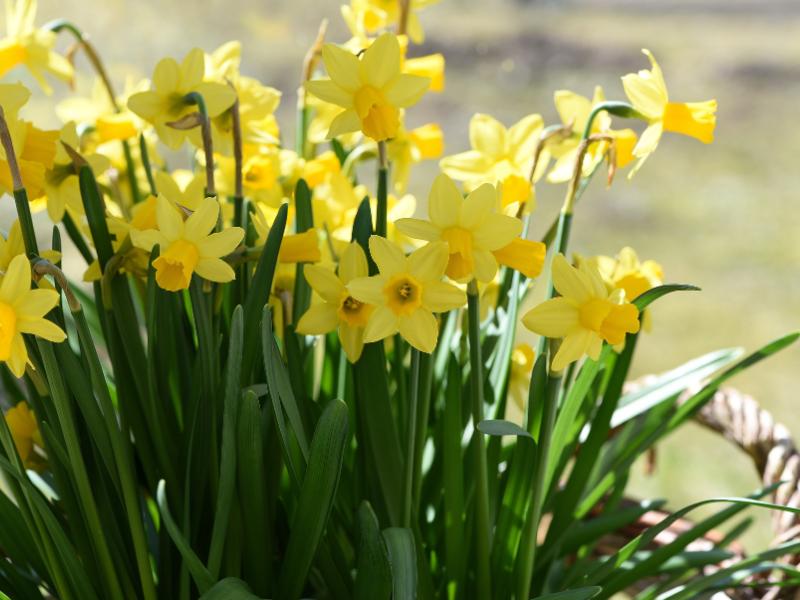
These magnificent spring flowers can be seen all around France in countryside gardens and fields. You can even see some of them around the Eiffel Tower!
Here is the basic information about French daffodils:
| Scientific name: | Narcissus |
| French name: | Jonquille |
| Native habitat: | Northern Europe |
| Growth rate: | Fast growers |
| Size: | 5-60 centimeters (2-24 inches) tall stems, depending on the variety |
| Toxicity: | Toxic |
Almost every beautiful flower is toxic, which is very unfortunate. Nonetheless, that doesn’t deter people from growing daffodils and creating beautiful flower arrangements.
Daffodils are some of the earliest blooming flowers, and their orange trumpets and sun-yellow petals light up any place they are placed in. The trumpets can also be yellow or pink, while the petals vary between yellow and white. The combination of these colors will have your dark-lit room brimming with vibrancy.
Daffodils require well-draining soil and a lot of sun to bloom. Apply frequent watering techniques when the flowers bloom, but cut back when the plant enters dormancy. Fish emulsion is an excellent fertilizer that you can give them, especially during spring. However, they’ll also do well even without the fertilizer.
In France, these beautiful flowers act as a sign of hope and represent new beginnings and rebirth.
3. Azalea
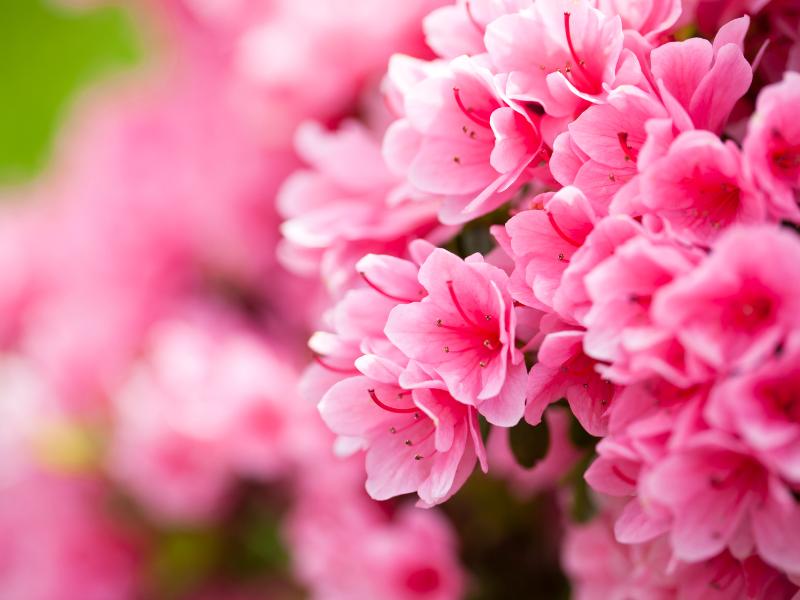
Here is the general information regarding azalea:
| Scientific name: | Rhododendron |
| French name: | Azélie |
| Native habitat: | Japan, Korea, and China |
| Growth rate: | Slow grower |
| Size: | 6 meters (20 ft), but garden varieties reach heights between 1.2-1.8 meters (4-6 ft) |
| Toxicity: | Toxic to cats and dogs |
This flowering shrub blooms in spring and will embellish your garden with white, pink, purple, yellow, orange, and red flowers.
Azalea needs fertile, well-draining soil and full sunlight. However, it can also tolerate partial shade. As it grows, the plant needs 2.5 cm (about an inch) of water per week.
Azalea is widely known across the world since it symbolizes family and familial duty. The flower also represents wealth, passion, feminine beauty, womanhood, and elegance. Each flower with its unique color has its own meaning.
4. French Lilac
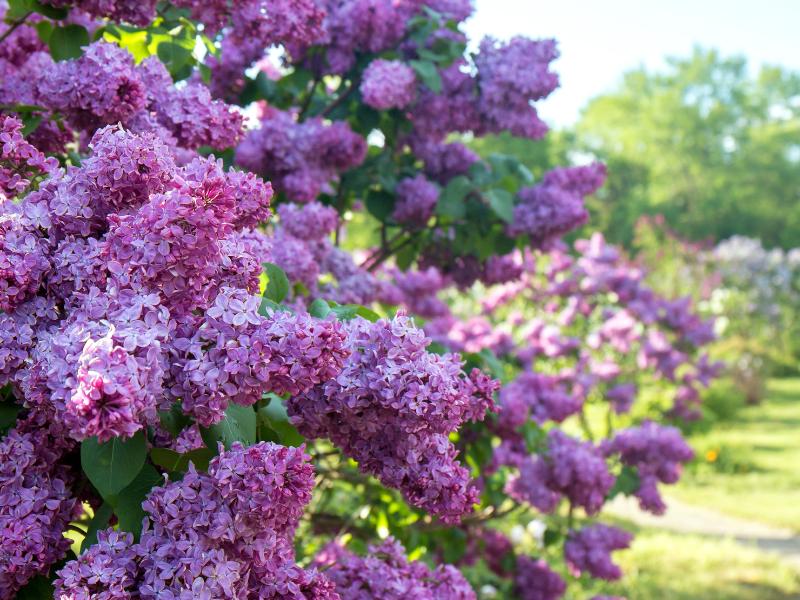
Lilac is an ideal plant for those who live in cottages. It’s a spring-flowering bush that has a pleasant fragrance.
Here are the basic details:
| Scientific name: | Syringa vulgaris |
| French name: | Lilas |
| Native habitat: | The Balkans |
| Growth rate: | Medium growth rate |
| Size: | 2.4-4.5 meters (8-15 ft) when mature |
| Toxicity: | Non-toxic |
Place the cut flowers of French lilac in a vase, and they’ll adorn your home for two weeks as long as you take care of them. The flowers vary between pink, white, mauve, lavender, and periwinkle-blue. They bloom in spring, and neighbors and guests will smell their fragrance from far away.
Water the plant twice a week and provide it with plenty of sun. Over-fertilization prevents French lilacs from blooming, so it would be best to use compost or organic fertilizer. The plant requires a well-draining medium, and pruning should be done after it blooms.
Lilacs signify spring and renewal, but they also represent confidence. They are one of the earliest blooming flowers and an ideal gift for someone who has just graduated.
5. Carnation

In French, carnation is called œillet ( I know, tough word to pronounce!).
Here are the general details for this beauty:
| Scientific name: | Dianthus caryophyllus |
| French name: | Œillet |
| Native habitat: | Mediterranean |
| Growth rate: | Slow grower |
| Size: | 30-75 centimeters (1-2.5 ft) tall |
| Toxicity: | Toxic to dogs and cats |
Carnations are found worldwide, and every gardener dreams of having them on their premises. They are very popular in France and in Spain as well.
Carnations come in yellow, white, pink, red, and scarlet and can be multicolored. Put them in a vase, and you’ll be astonished at how long they last!
They require a fertile, well-drained substrate and a lot of sunlight. Water the flowers once or twice a week when the top few inches of the soil are dry.
The meanings of each color of carnations vary from distinction, purity, disappointment, protection, healing, fascination, love, strength, and more. All I can tell you is, maybe don’t gift a fellow florist a yellow incarnation!
6. Dahlias
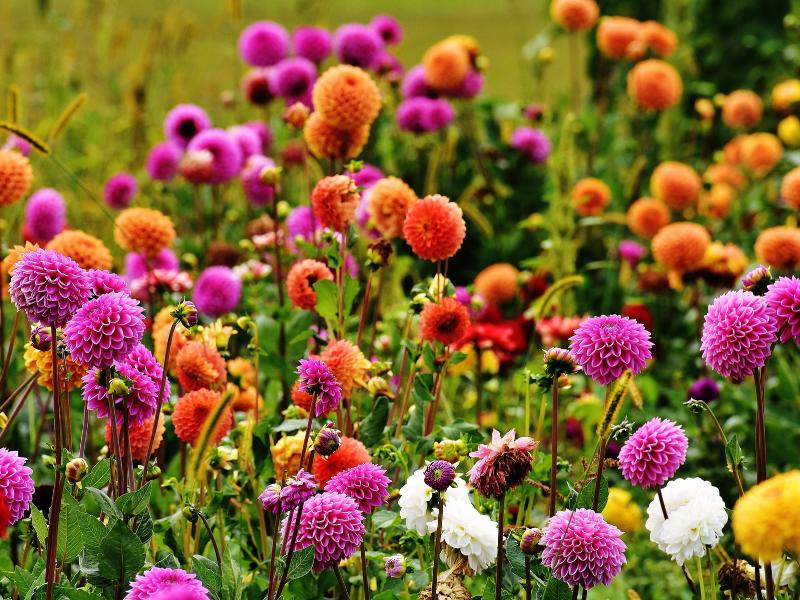
These flowers come in many sizes and shapes and will be an excellent addition to your garden.
Here is the general information:
| Scientific name: | Dahlia |
| French name: | Dahlia |
| Native habitat: | Higher altitudes of Mexico and Central America |
| Growth rate: | Fast growers |
| Size: | Most varieties are around 1.2-1.5 meters (4-5 ft) tall |
| Toxicity: | Toxic to dogs and cats |
Dahlias bloom from midsummer to fall, but if you happen to be in southern France, you’ll probably notice them in November or December. Whether huge bouquet-worthy flowers or tiny pom poms, dahlias come in pink, lavender, red, orange, yellow, peach, and white.
Plant them in a loose, well-draining medium and place them in a sunny spot. Water the flowers deeply once or twice a week. You can invest in a drip irrigation system to make work easier.
Dahlias symbolize love and involvement. This is one of the reasons why they are usually paired with roses. They also represent elegance and wealth, and they became popular in France when Empress Josephine began to grow them.
7. Gardenia
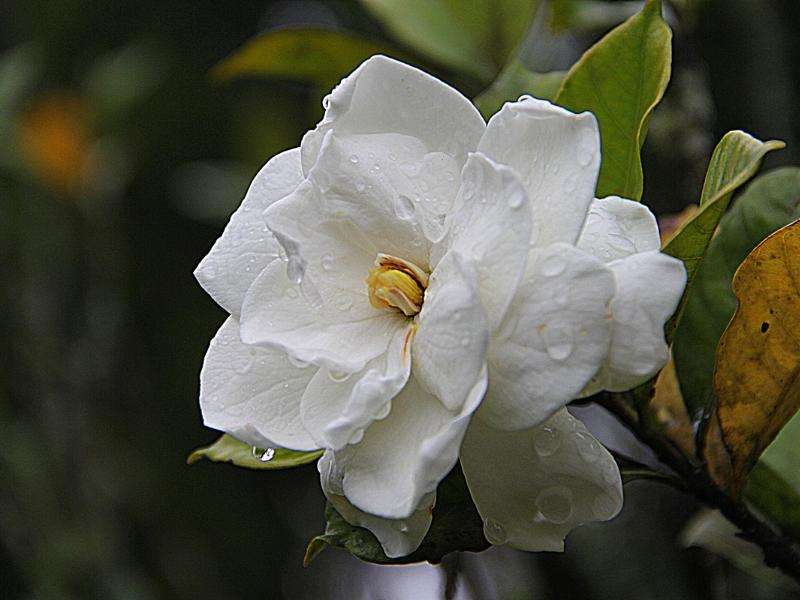
Gardenia are incredible bushes epitomized by their beautiful white flowers.
Here are the primary specifics about the plant:
| Scientific name: | Gardenia jasminoides |
| French name: | Gardénia |
| Native habitat: | Southeast Asia |
| Growth rate: | Moderate growth rate |
| Size: | Average height is 1-1.5 meters (4-5 ft), but there are taller varieties |
| Toxicity: | Toxic to pets (they are not deadly, though) |
Gardenia bushes come in cream, ivory, or white blossoms that will indeed adorn your garden. They bloom from late spring to early summer and are excellent for gorgeous flower arrangements.
Gardenias flourish in full sun. However, provide it with some shade when the summer heat increases. Plant it in a fertile, well-draining medium that retains some moisture. Rain water should be sufficient for the watering requirements of this plant, but ensure it gets 2.5 centimeters (almost an inch) of water a week if that’s not possible.
Gardenias represent modesty, sincerity, innocence, purity, and gentleness. You can use these meanings to express your true feelings and emotions with fellow flower enthusiasts.
8. French Marigold
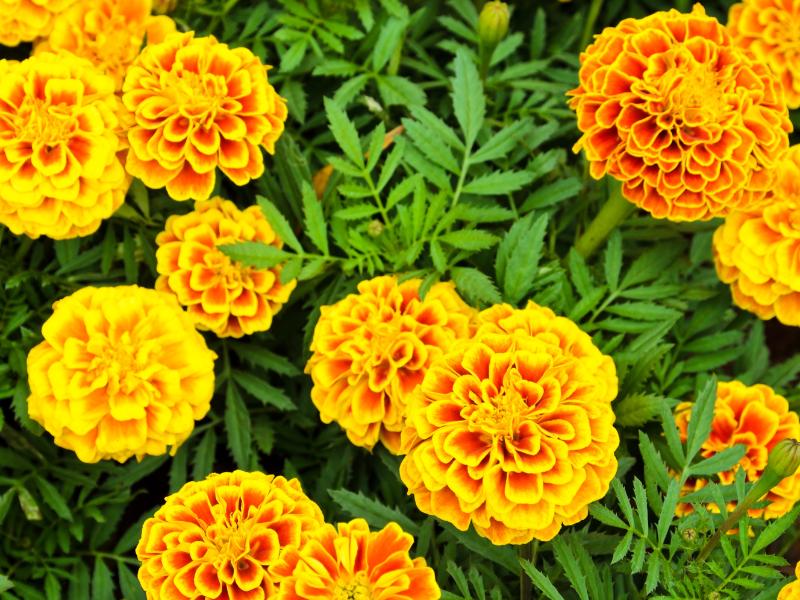
Your countryside garden will light up once you place this vibrant-colored flower!
Here is the general information:
| Scientific name: | Tagetes patula |
| French name: | Souci |
| Native habitat: | Mexico and Central America |
| Growth rate: | Fast growing |
| Size: | 15-30 centimeters (6-12 in) tall |
| Toxicity: | Toxic to pets |
These gorgeous flowers bloom in early spring until the first frost. They have majestic flower heads in red, orange, and yellow.
Water the plant thoroughly once a week and plant it in well-draining and moderately fertile soil. The plant flourishes in full sun and won’t be harmed by scorching summer days.
French marigolds symbolize jealousy, despair, sorrow, and grief but also signify creativity and passion. Let’s just say you don’t want them near weddings. Although, they’ll be the center of attraction in your living room when you fill them in a vase because they are splendid.
9. French Hyacinth
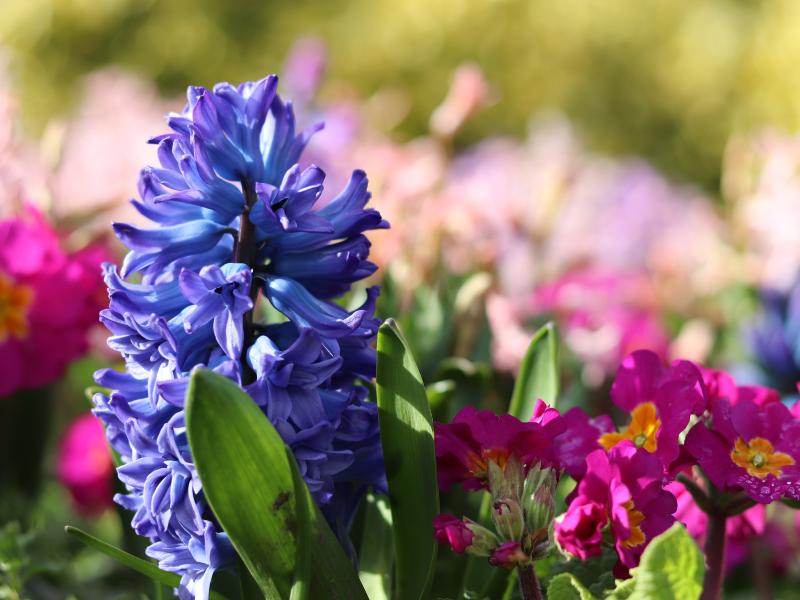
Are you afraid of snakes? I mean, most people are. Well, hyacinths resemble a rattlesnake’s tail, but there’s nothing to fear!
Here are the basics about hyacinths.
| Scientific name: | Hyacinthus |
| French name: | Jacinthe |
| Native habitat: | The Eastern Mediterranean |
| Growth rate: | Fast grower |
| Size: | Approximately 25 centimeters (10 in) and 10-15 centimeters (4-6 in) wide |
| Toxicity: | Toxic |
Hyacinths will be a great addition to your countryside home, but you should probably keep your dogs and cats away. This plant has a slender stem that bears white, pink, or light blue star-like flowers, which bloom in spring.
Hyacinths need plenty of sunlight. Water them when the soil’s top 7.5 centimeters (3 in) is dry. The plant also needs well-drained soil to thrive. Add organic fertilizer or compost to give your plant nutrients and encourage growth. Within no time, you’ll be enjoying pink flowers in late spring.
Hyacinths symbolize commitment, beauty, and peace. They are associated with the Greek god Apollo, and that’s why they also represent power and pride. Blue hyacinths normally represent sincerity, while yellow ones signify jealousy.
10. French Lavender
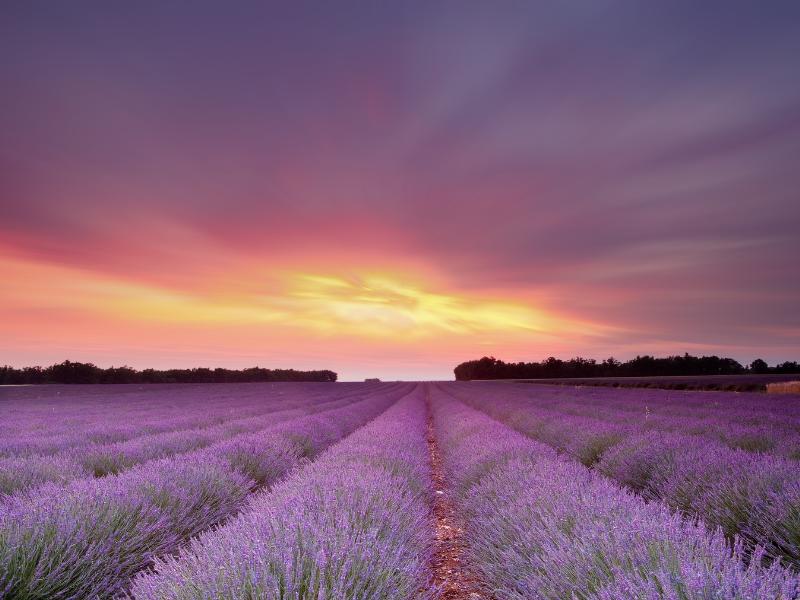
Lavender is a popular flower across the world. It has a ravishing scent, and its delicate stems provide numerous benefits.
Below is the general information about French lavender.
| Scientific name: | Lavandula dentata |
| French name: | Lavande de Provence |
| Native habitat: | The Atlantic islands, the Arabian peninsula, and the Mediterranean |
| Growth rate: | Fast grower |
| Size: | 90 centimeters (3 ft) tall |
| Toxicity: | Toxic to dogs and cats |
Knowing when the flowers bloom is very helpful if you plan to grow any variety of lavender. French lavender needs plenty of care, but it won’t disappoint at all with its beautiful flowers. The flowers normally bloom in early spring.
French lavender needs a sandy medium and a lot of sunlight to thrive. You need only water the plant every two weeks as it grows since it’s relatively drought-tolerant. One thing you should note is that lavender doesn’t like humidity. Therefore, if you live in a place with high precipitation, you should probably grow it indoors.
Lavender signifies calmness, serenity, grace, devotion, purity, and silence. The flower is a symbol of Provence and exemplifies healing and innocence. You can use the plant to add a calming atmosphere to your home.
11. Geranium
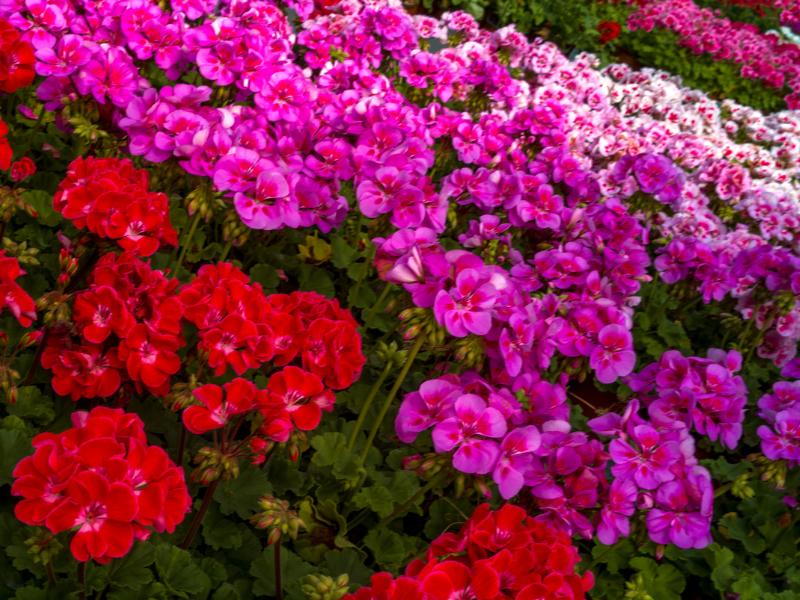
Whether you place them in hanging baskets on your terrace or use them as bedding plants, geraniums create a picturesque view that will amaze you.
Here is the general information:
| Scientific name: | Geranium |
| French name: | Géranium |
| Native habitat: | Subtropical southern parts of Africa |
| Growth rate: | Slow grower |
| Size: | 10-120 centimeters (4-48 in) tall |
| Toxicity: | Non-toxic |
Geraniums are also known as crane’s-bill and pelargoniums. They come in red, orange, purple, pink, or white and can resemble a four-leaf clover. These flowers start to bloom in spring and can go up to fall.
Geraniums require 4-6 hours of direct light. Increase the duration if you are using filtered light. Water the plant when the soil’s top 1.25 centimeters (½ in) is dry. Use a nutrient-rich medium that’s also loose to avoid overwatering.
Geraniums are a symbol of good health, friendship, good wishes, and happiness. In the Victorian era, however, they represented stupidity and foolishness, so maybe don’t go ahead gifting your close friends!
12. Lily Of The Valley
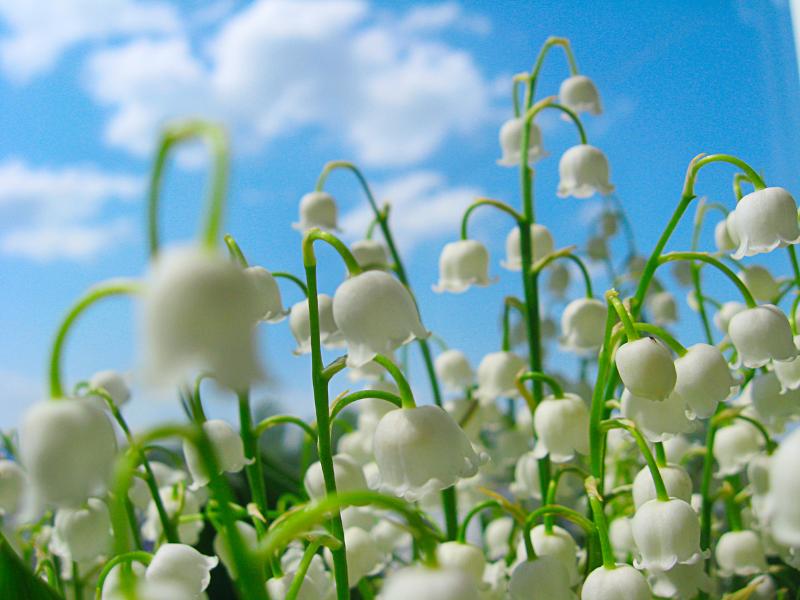
Lily of the Valley was used as a gift for many centuries and played a significant part in French history. King Charles IX is credited with having started the tradition of using these flowers as gifts after he loved them so much when they were delivered.
Below are the specifics regarding this flower:
| Scientific name: | Convallaria majalis |
| French name: | Muguet |
| Native habitat: | Eastern parts of North America and Eurasia |
| Growth rate: | Fast-growing |
| Size: | 15-30 centimeters (6-12 in) tall |
| Toxicity: | Toxic |
Because of its shape, you may think this flower is the lily flower on the fleur-de-lis emblem, but they aren’t the same. Still, lily of the valley is grown all over France.
The plant has bell-shaped white or pink flowers that bloom in early to mid-spring. These flowers can last 3-4 weeks.
Depending on the humidity, the plant thrives in partial shade but can also tolerate full sun or full shade. Plant it in well-draining and moist soil. The watering regimen will depend on the amount of sunlight your plant receives.
In France, people still continue with the tradition of King Charles IX by giving their family members these flowers during Fête du Muguet (Labour Day). They act as a symbol of good luck for the upcoming year.
13. Gerbera Daisy
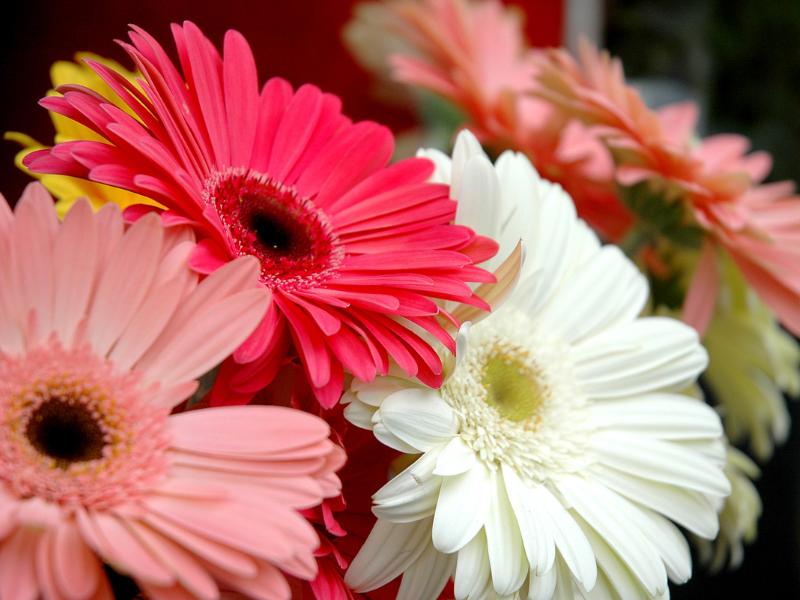
Gerbera daisies are vibrant flowers that are pretty popular in France.
Here are the specifics:
| Scientific name: | Gerbera jamesonii |
| French name: | Gerbera de Jameson |
| Native habitat: | South Africa |
| Growth rate: | Moderate growth rate |
| Size: | 15-45 centimeters (6-18 in) tall |
| Toxicity: | Non-toxic |
Gerbera daisies will adorn your garden with red, orange, yellow, lavender, pink, salmon, and white blossoms; one of the reasons why the French love them so much! The flowers bloom from late spring until fall. Some gardeners even take the bold route and decide to grow only bicolor cultivars.
They thrive in full sun, but ensure you provide them with some shade during the hot summer months. They need fertile, well-draining soil and 2.5 centimeters (1 in) of water weekly.
Gerbera daisies represent purity, innocence, and beauty, but their vibrant colors embody energy and rejuvenation. This is an ideal flower to give to your family or friends.
14. Gladiolus
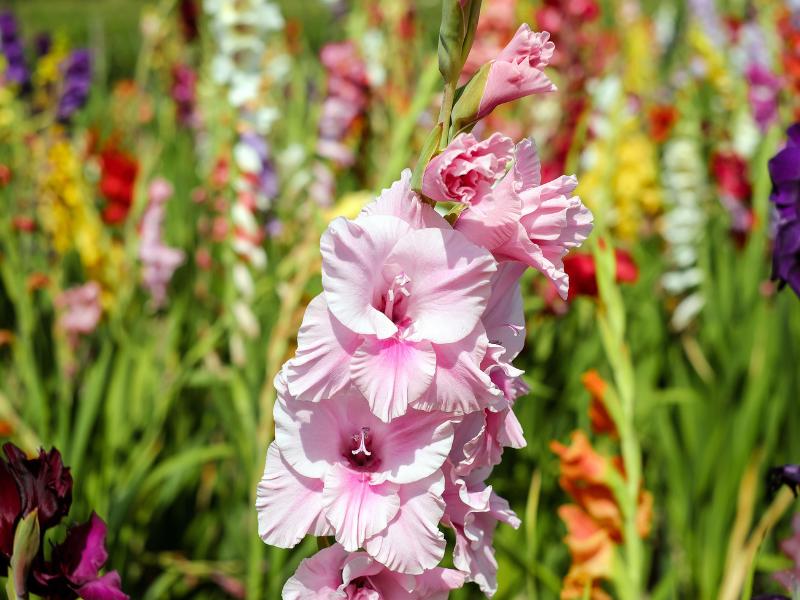
Gladiolus is also referred to as the sword lili due to its appearance. You can see it when strolling down the alleys of Paris, and they are adored by the French.
Here is the general information regarding gladiolus:
| Scientific name: | Gladiolus |
| French name: | Glaïeul |
| Native habitat: | Europe and Africa |
| Growth rate: | Slow grower |
| Size: | 60-150 centimeters (2-5 ft) tall |
| Toxicity: | Toxic to dogs and cats |
They come in green, yellow, burgundy, purple, lavender, rose, pink, or white. They bloom from July until the frost kills them, and they’ll be a great addition to your front yard.
Gladioli require full sun to thrive, and a well-draining, loam-sandy substrate is vital. The plant needs 2.5 centimeters (1 in) of water, either through irrigation or rain, every week. Add compost before planting to get the most beautiful flowers.
This flower signifies sincerity, strength, and love at first sight. So, if your suitor surprises you with a bouquet of Gladioli, your guess is as good as mine…
15. Gourdon Flowers
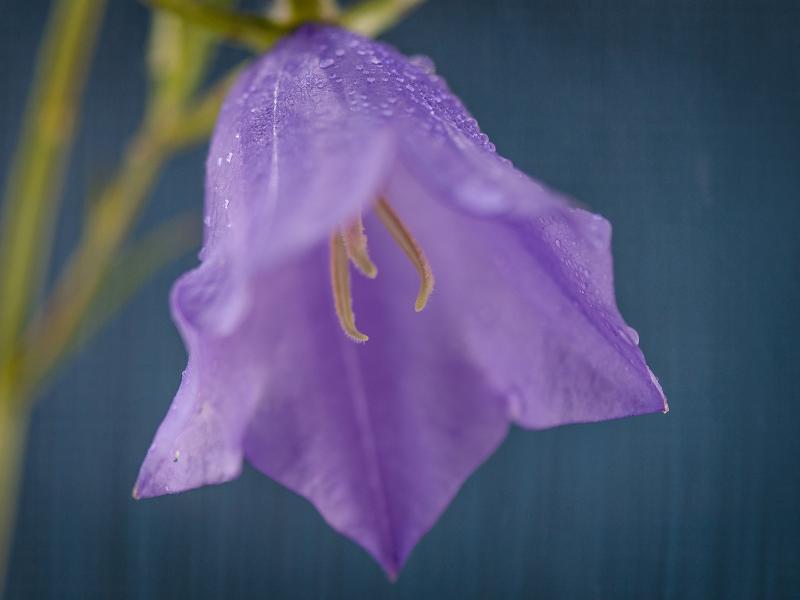
These wildflowers are also called Rainer’s bellflower and are a common sight in Paris.
Here is the basic information:
| Scientific name: | Campanula raineri |
| French name: | Gourdon |
| Native habitat: | Swiss and Italian Alps |
| Growth rate: | Slow-growing |
| Size: | 5-7.5 centimeters (2-3 in) tall and approximately 20 centimeters (8 in) wide |
| Toxicity: | Non-toxic |
These beautiful flowers manifest during the French spring and summer, and their trailing, lavender-blue bells are a sight to behold!
Plant them in well-draining, loamy and sandy soil, and place them in a sunny spot for them to reach their full potential. Water the plants regularly since the soil needs to be moist.
Gourdon flowers are associated with St. Dominic, a teacher of penance and devotion, and they represent penitent piety and humility in Christianity. St. Dominic abandoned all luxuries, including beds, shoes, and even food, and wore torn clothes. Most people believe the flowers facing down are a sign of humility.
16. Hydrangea
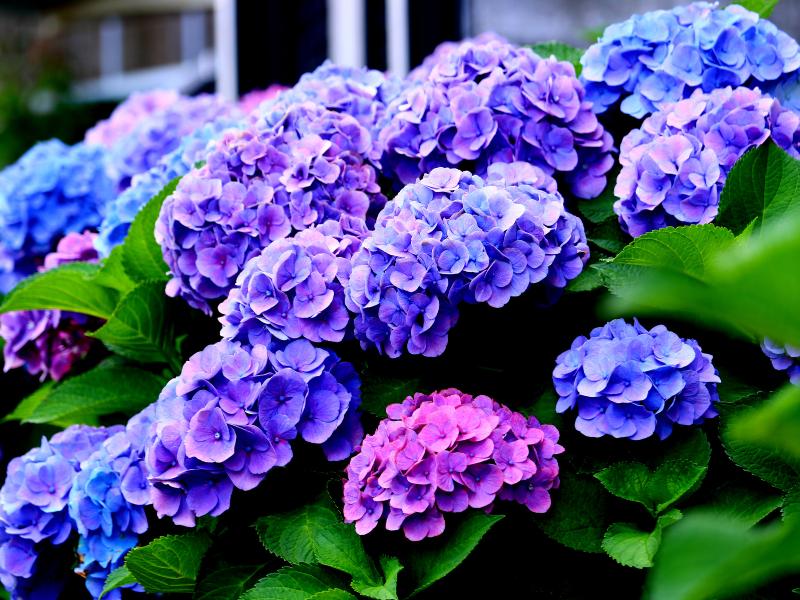
Hydrangea, also known as hortensia, is grown by gardeners across France, particularly in Normandy and Brittany. You’ll find the flowers in pots in most French households and sold in numerous flower shops in France.
Here is the general information about hydrangea:
| Scientific name: | Hydrangea |
| French name: | Hortense |
| Native habitat: | The Americas and Asia |
| Growth rate: | Fast-growing |
| Size: | Some species are 60-90 centimeters (2-3 ft) tall, while others reach a height of 1.8 meters (6 ft) |
| Toxicity: | Toxic to horses, dogs, and cats |
Hydrangeas produce blue or pink flowers in all shades of purple, violet, and lavender. Some species have white and green flowers. They bloom from mid-spring to late summer and sometimes even fall. Their flower heads can have multiple colors, which can be pastel or vibrant.
Hydrangeas flourish in partial shade. Ensure you place them in an area where they’ll receive direct morning sunlight and also be protected from the midday sun. Plant them in fertile, well-draining, and moist soil. They should receive 2.5 centimeters (1 in) of water every week during their growing season through irrigation or rain.
These flowers signify gratitude, grace, and beauty. In Europe, they symbolized boastfulness and arrogance. Pink hortensias symbolize heartfelt emotion, while blue ones represent rigidity and apology.
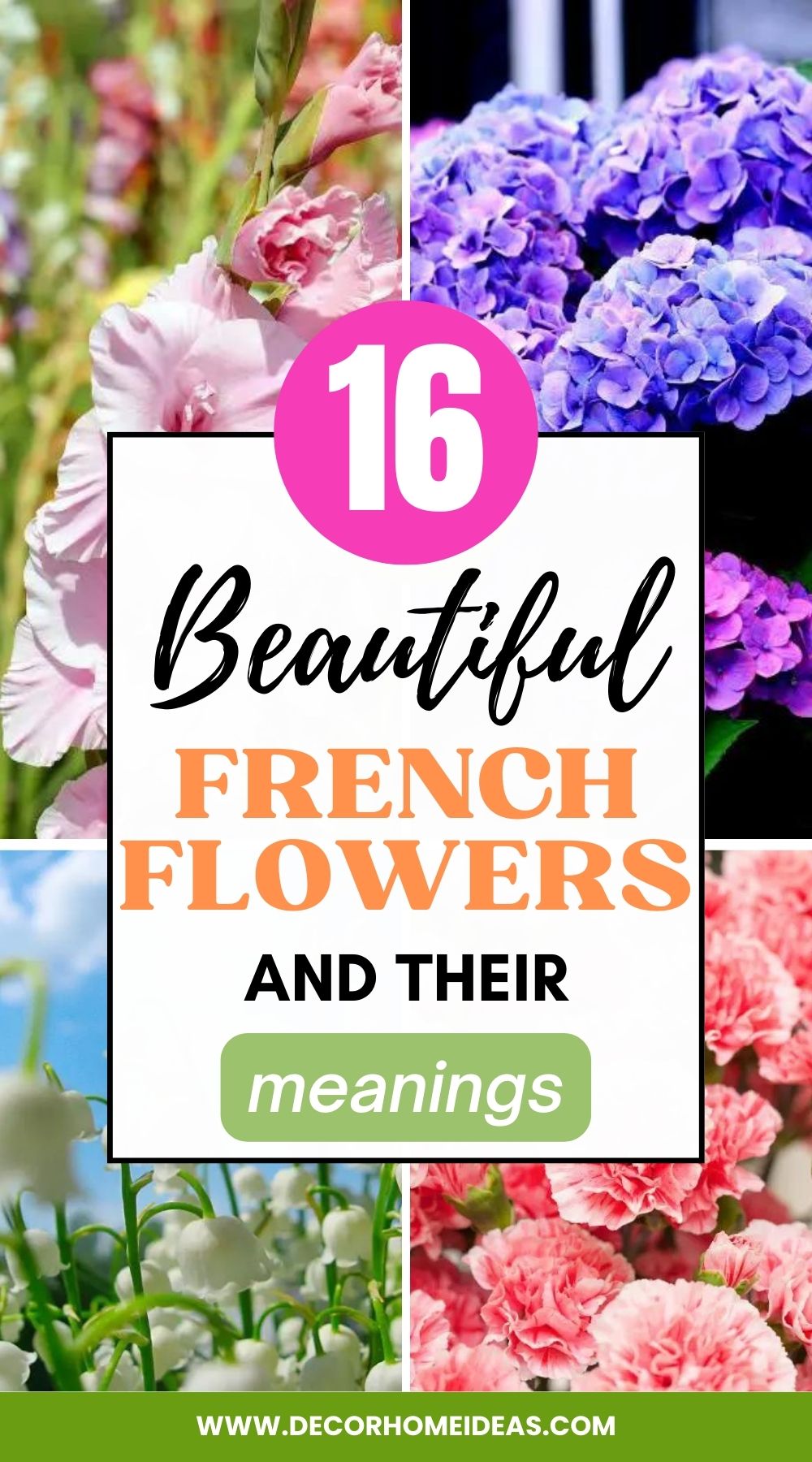
Conclusion
We have discussed some of the most popular flowers in France, and you can see them when strolling through Lyon, Bordeaux, Provence, or Paris.
The article also highlights the French names of the flowers to help you familiarize yourself with their local roots and significance.
We also included the hidden meanings of these flowers to help you choose the appropriate ones to give to a friend, family, or loved one. These flowers will also take your decor to the next level!
Have a wonderful day!

